Telling a place, its history, its function and its inhabitants through art: a task certainly not foreign to so many pictorial cycles we find around Italy, but which in Venice, in a particular setting and period, constituted an example that could be said to be almost unique in its kind, for the content and unity of its stories, for the exceptionality of the undertaking (a very rare case in the sixteenth century in the lagoon, the decoration was entrusted to a single artist), and for its destination. An environment that reached its maximum splendor and celebrity in the second half of the sixteenth century, thanks to the artistic contribution of one of the most important exponents of the Venetian school: Jacopo Palma il Giovane (Giacomo Negretti; Venice, 1549 - 1628). So it was precisely a Venetian artist who was commissioned to entirely decorate one of the most socially prominent places in the city and this was the occasion for the painter to accomplish one of his greatest masterpieces. That room, which we can still admire intact today, is part of an old hospital that was under the leadership of the Cruciferous Fathers at that time, and is now known as the Oratory of the Cruciferous.
It is located on the left side of the Campo dei Gesuiti, in the Cannaregio area, not far from the Fondamenta Nove. Externally, one would not think that the building hides a great masterpiece of the late Venetian Renaissance inside, but once inside a spectacular place is presented before the eyes of visitors, decorated on the ceiling and walls by the great paintings of Palma il Giovane. It is worth mentioning that today the Oratory can be visited thanks to the long and careful restoration work, promoted by UNESCO and financed by the IRE (Institutions of Shelter and Education) and a network of international committees devoted to the preservation of the Venetian capital, including Venice in Peril Fund (England), Pro Venezia (Sweden), Stichting Nederlands Comité Venetie (Netherlands), Friends of Venice (United States), put in place in order to restore it to its original state after nearly two decades of being closed to the public due to damage caused by the flood of November 4, 1966: in October 1984 visitors were thus able to return to admire this significant cultural site. Significant because, in addition to representing one of the artist’s masterpieces, it constitutes a kind of exception for the Venetian artistic environment of the sixteenth century, since it is the only decorative complex of that period to have been created solely by a single artist, if we exclude the three rooms masterfully decorated by Jacopo Robusti, known as Tintoretto, in the Scuola Grande di San Rocco from 1564 to 1588. Moreover, unlike Tintoretto, who did not depict the story of Saint Roch in the Sala Terrena, the Sala Capitolare, and the Sala dell’Albergo (he executed only the Saint Roch in Glory in the Sala dell’Albergo), Palma the Younger found himself recounting in painting some of the events in the history of the Cruciferous Fathers. A kind of book made of images thanks to which visitors of now almost seven hundred years have the opportunity to learn important passages of the events of those who led this architectural complex.
It was Doge Pasquale Cicogna (Venice, 1509 - 1595) who commissioned this great cycle of works of art that was meant to celebrate the Crucifers (“Palma’s masterpiece,” according to art historian Augusto Gentili, but also according to many who have tackled the study of these canvases): according to records, on March 10, 1586 Palma il Giovane received a deposit of twenty ducats for three paintings with the deeds of the almost 80-year-old doge Cicogna destined for the Oratorio dei Crociferi. Payments continued until August 1, 1587, when the artist received eighty ducats as the balance. The pictorial cycle was created between 1583 and 1592, in what the great art historian Pietro Zampetti called “the most balanced period of the artist’s activity,” and consisted of eight large canvases. The Venetian artist already belonged to a family devoted to art: it was no accident that Giacomo Negretti, his real name, was nicknamed Palma the Younger to distinguish him from Jacopo Palma the Elder (Venice, 1549 - 1628), his great-uncle and also named Giacomo Negretti, and his mother’s brother was Bonifacio de’ Pitati, better known as Bonifacio Veronese (Verona, 1487 - Venice, 1553). Il Giovane trained in Venice and Rome (the duke of Urbino, Guidobaldo II Della Rovere, noticed his abilities and induced him to spend a stay here) and his art was indebted mainly to that of Titian and Tintoretto, thus capturing the traits of the Venetian school, of which he later proved to be a notable exponent, and of Roman Mannerism; in particular of the latter he grasped the naturalistic motifs that we find in the works of the Oratory.
 |
| The Oratorio dei Crociferi in Venice |
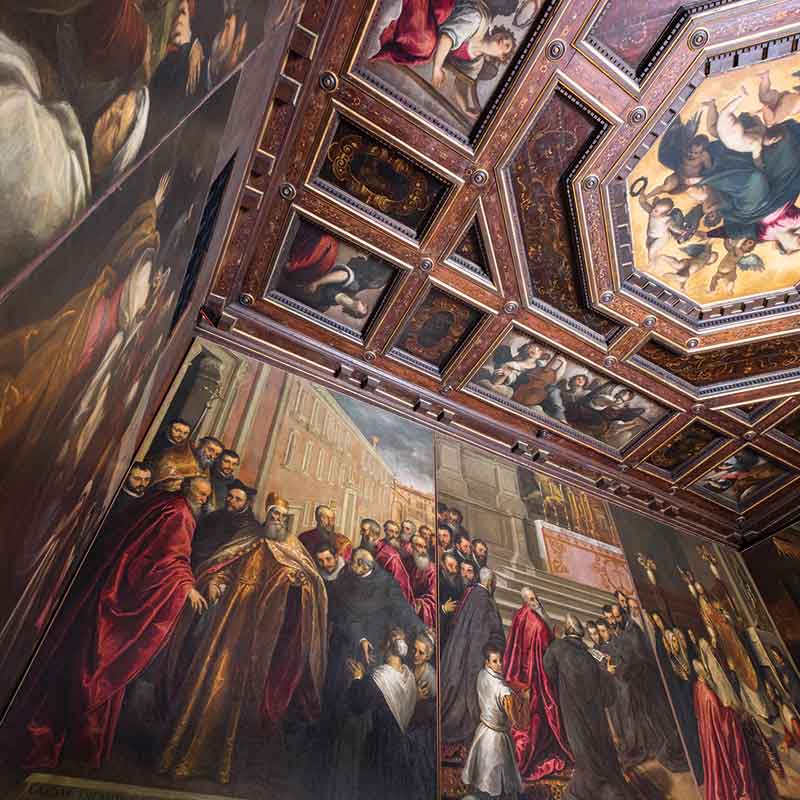 |
| Interior of the Oratorio dei Crociferi in Venice, the canvases of Palma il Giovane |
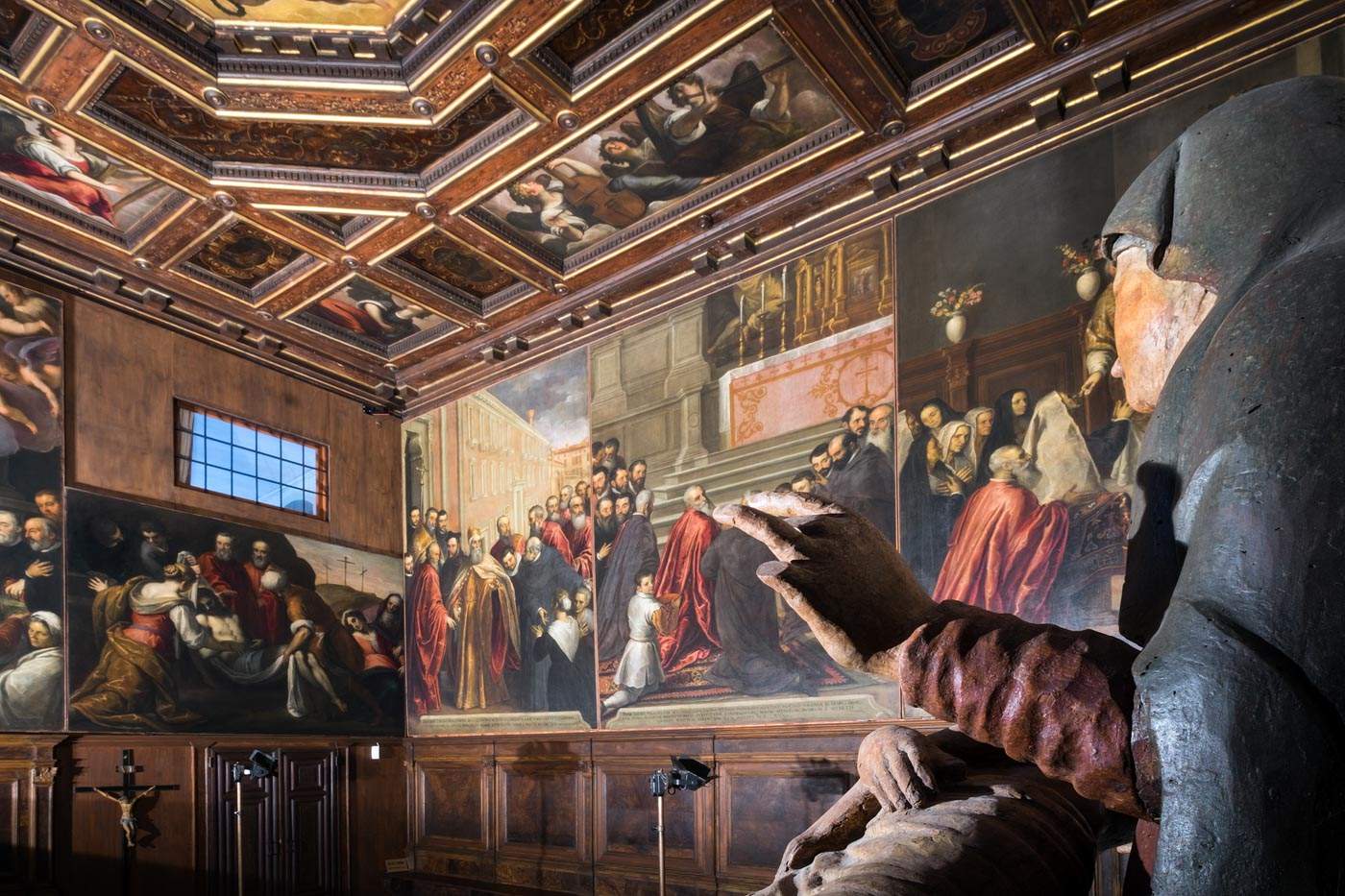 |
| Interior of the Oratory of the Crucifers in Venice, the canvases by Palma il Giovane |
 |
| Interior of the Oratory of the Crucifers in Venice, the canvases of Palma the Younger |
That said, it is necessary to take a step back to understand why the Cruciferous Fathers played such a significant role in Venice that the doge decided to commission the aforementioned cycle: between the 11th and 12th centuries, the congregation of the Cruciferous Fathers was becoming considerably established and widespread and decided to build a hospital in the Campo dei Gesuiti, in the northern part of Venice, at that time still mostly marshy, in order to care for the sick and to house the merchants, soldiers and pilgrims who were heading to or returning from the Holy Land during the Crusades. The building had a simple gabled structure, and an adjacent church dedicated to Our Lady of the Assumption was built, burned down in 1214 and rebuilt with larger dimensions. Fundamental to the hospital’s self-support was the considerable amount of money donated in 1268 by Doge Renier Zen. However, in the 15th century the old hospital became a hospice to house a small group of lonely and needy women in a space that included fifteen rooms arranged on two floors. Since its construction, the complex has been closely linked to the aid and protection of the most needy; indeed, in the Republic of Venice this mutual relationship between devotion and assistance, civil ideology and religious ideology, was frequent. And such a link is intrinsic to the Cruciferous Fathers themselves: they probably belonged to an order formed in the East, but their own origins go back even to the earliest Christians. According to their claims, they were founded by St. Cletus and were refounded by St. Cyriacus, Patriarch of Jerusalem in the fourth century; later, in 1169 Pope Alexander provided them with a constitution and rule similar to that of the Augustinians. And they were one of the orders that flanked the Templars in the Crusades.
Of the works created by Palma the Younger, the painter and writer Carlo Ridolfi (Lonigo, 1594 - Venice, 1658) was already speaking in 1648, in his treatise Le maraviglie dell’arte, a collection of biographies of illustrious Venetian painters, describing the young Giacomo Negretti, at the time of thetime of the creation of the canvases little more than thirty-five years old, as “always devoted” to the Cruciferous fathers “since until he was a child he was had in protection by them,” and then spoke of the frescoes in these terms: "in the middle of the ceiling he did Our Lady assumed to Heaven, and in eight spaces around Angels with musical instroments, and in the altar the Adoration of the Magi, in one of which he portrayed Father Liberale Marini prior of that time. On the right side, St. Cletus pontiff, institutor of that Religion, confers on the said Fathers a Brief, in which is noted: CLETVS P.P. INSTITVTOR RELIGIONIS CRVCIFERORVM. On the left, Pontiff Paul IV presents another Brief to the Venetian Ambassador, where it is noted: PAVLVS P.P. IV AD PERPETVAM REI MEMORIAM, INTVITV SERENISSIMI PRINCIPIS ET DOMINI VENET. PER EORUM ORATIONEM NOBIS SVPPLICANTIVM. And in this action intervene Father Benedetto Leoni was general of that congregation and bishop of Arcadia, and Father Contarino author of the Giardino istorico, drawn from the natural. Above the entrance door is Our Lord Scourged, in which Palma wished to compete with that of Giuseppe d’Arpino given to prints, which is in true scholarly effort. In the near corner pretended the doge Reniero, Zeno, and the dogaressa Aloisa contessa di Prata, his wife. [...] In the following compartment, over the other door, our Lord is placed in the monument by the pious friends, and in the person of Gioseffo is portrayed Mr. Luca Michele procurator of St. Mark. In the other part of the wall divided into three large pictures the actions of Doge Cicogna; and in the first, near the right side of the altar, stands those in the dress of Senator at Mass adoring the Blessed Sacrament, administered by Father Priamo Balbi, then ospitaliere, and some women of the said ospitaliere represented [...]; in the second, while he is present at the divine praises sung by the same Fathers, a little boy brings him the new date of his creation [...]; in the third we see the same Prince in ducal garments visiting the said place, as he always used to do each year on the day of the Assumption of the Virgin, accompanied by the Ambassadors of the Princes and Senators." Palma’s cycle is still almost intact: compared to the time of its creation, only the altarpiece that was on the altar is missing.
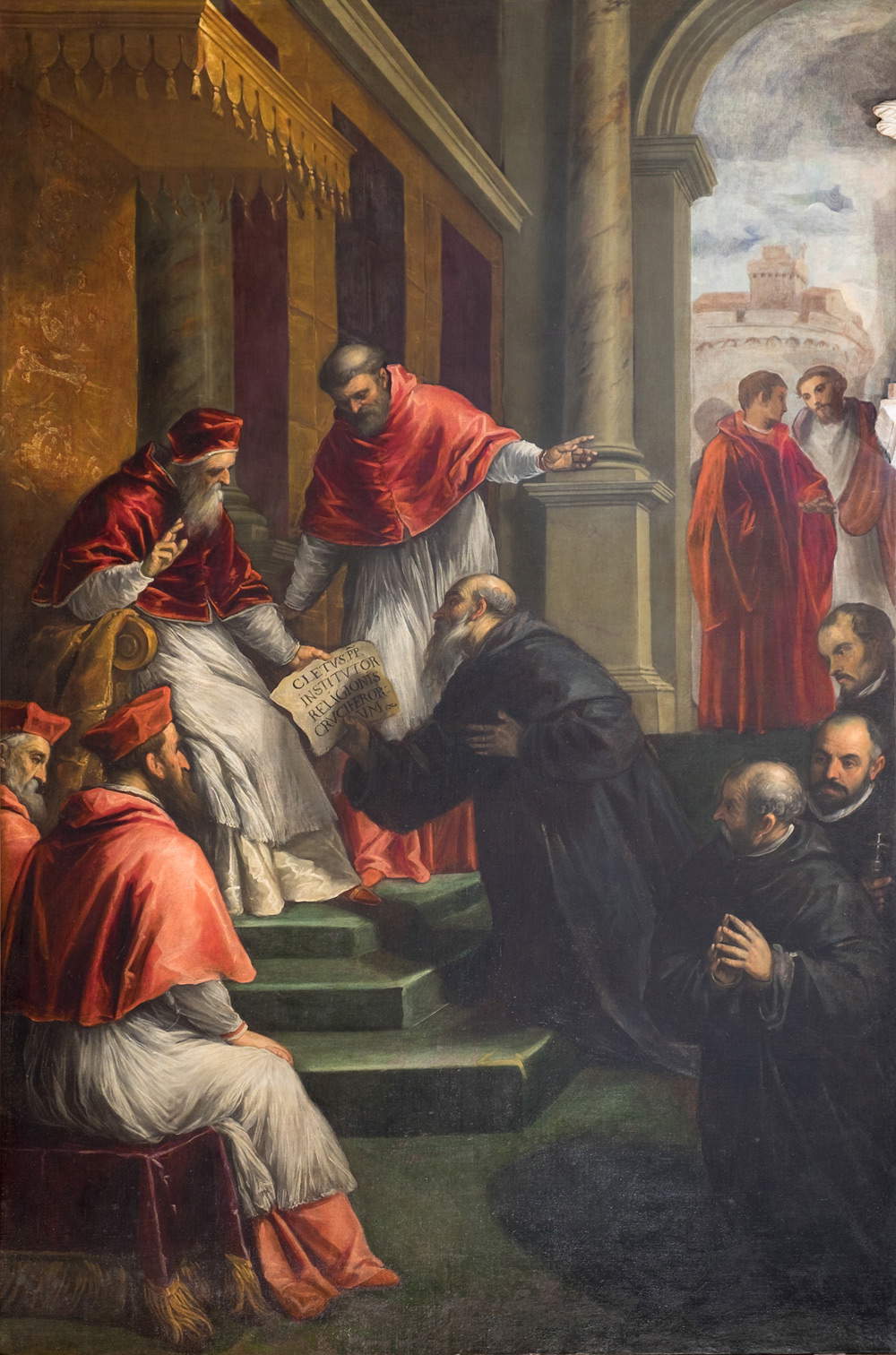 |
| Palma il Giovane, Pasquale Cicogna in Doge’s robes visits the church and hospital of the Crociferi (1586-1587; oil on canvas, 369 x 262 cm; Venice, Oratorio dei Crociferi) |
 |
| Palma il Giovane, Pasquale Cicogna in dogal robes visits the church and hospital of the Crociferi (1586-1587; oil on canvas, 369 x 262 cm; Venice, Oratorio dei Crociferi) |
 |
| Palma the Younger, Pasquale Cicogna attends the mass celebrated in the ’oratorio dei Crociferi by Father Priamo Balbi (1589-1590; oil on canvas, 350 x 223 cm; Venice, Oratorio dei Crociferi) |
 |
| Palma the Younger, Pope Paul IV Delivers a Brief to the Venetian Ambassador (1589-1590; oil on canvas, 350 x 223 cm; Venice, Oratorio dei Crociferi) |
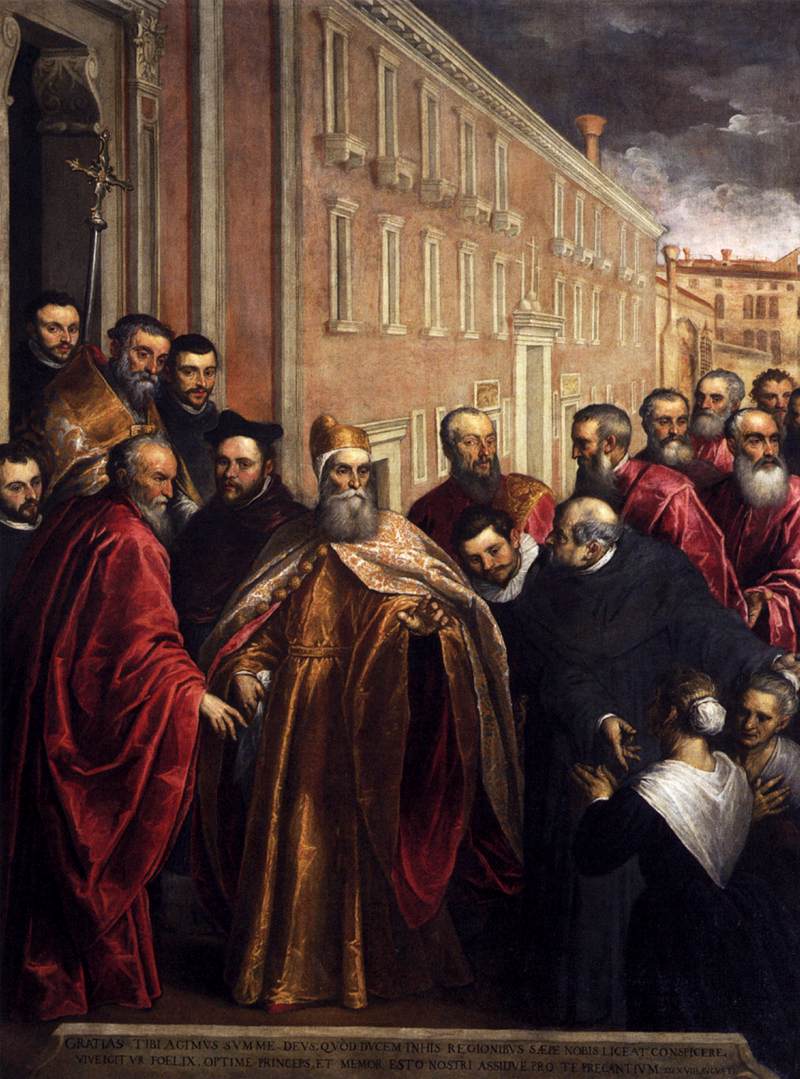 |
| Palma the Younger, Pasquale Cicogna in Doges’ robes visits the church and hospital of the Cro ciferi (1586-1587; oil on canvas, 369 x 262 cm; Venice, Oratorio dei Crociferi) |
 |
| Palma il Giovane, Flagellation of Christ (1591-1592; oil on canvas, 320 x 345 cm; Venice, Oratorio dei Crociferi) |
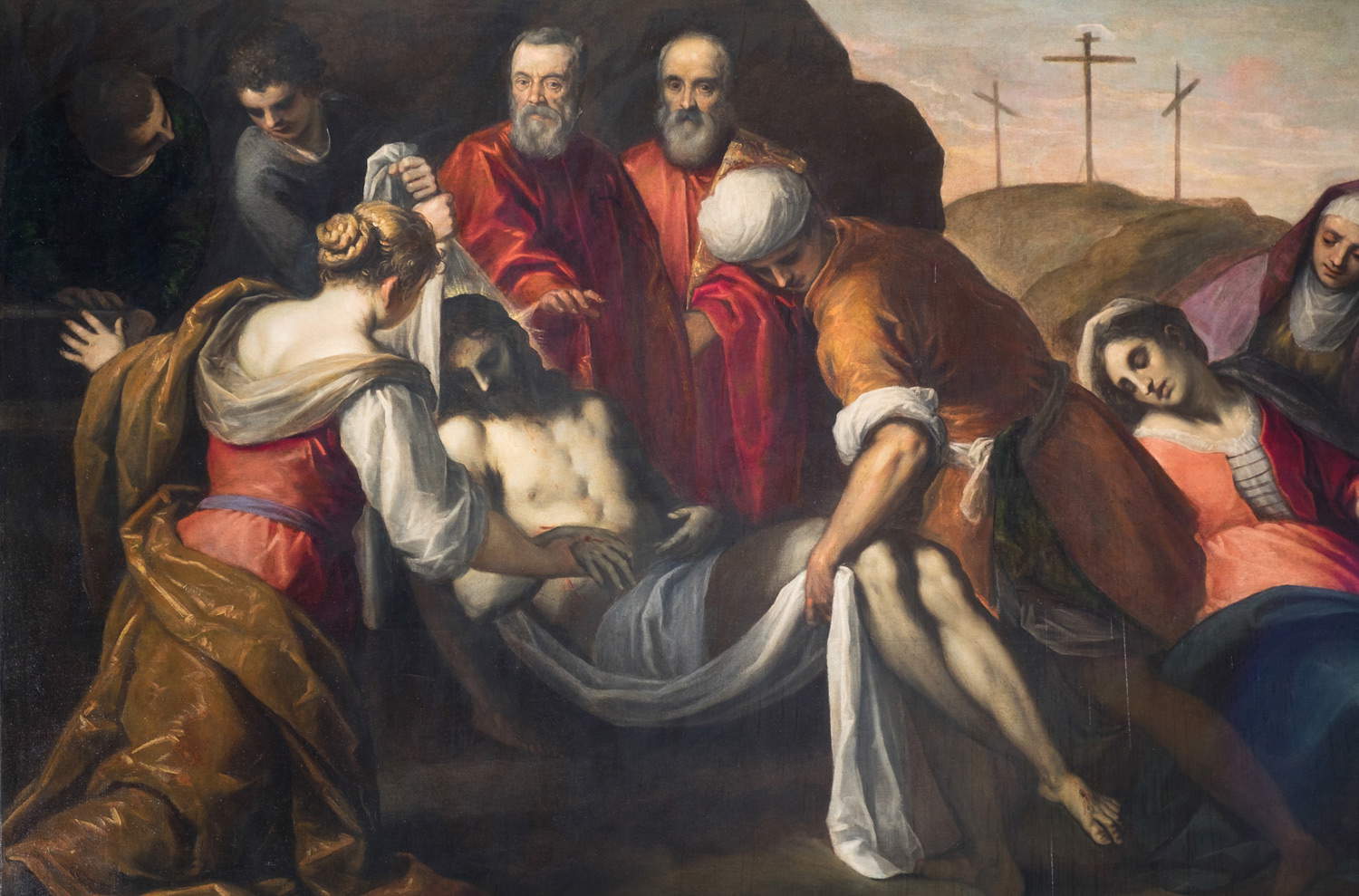 |
| Palma il Giovane, Transport of the Dead Christ (c. 1590; oil on canvas, 203 x 292 cm; Venice, Oratorio dei Crociferi) |
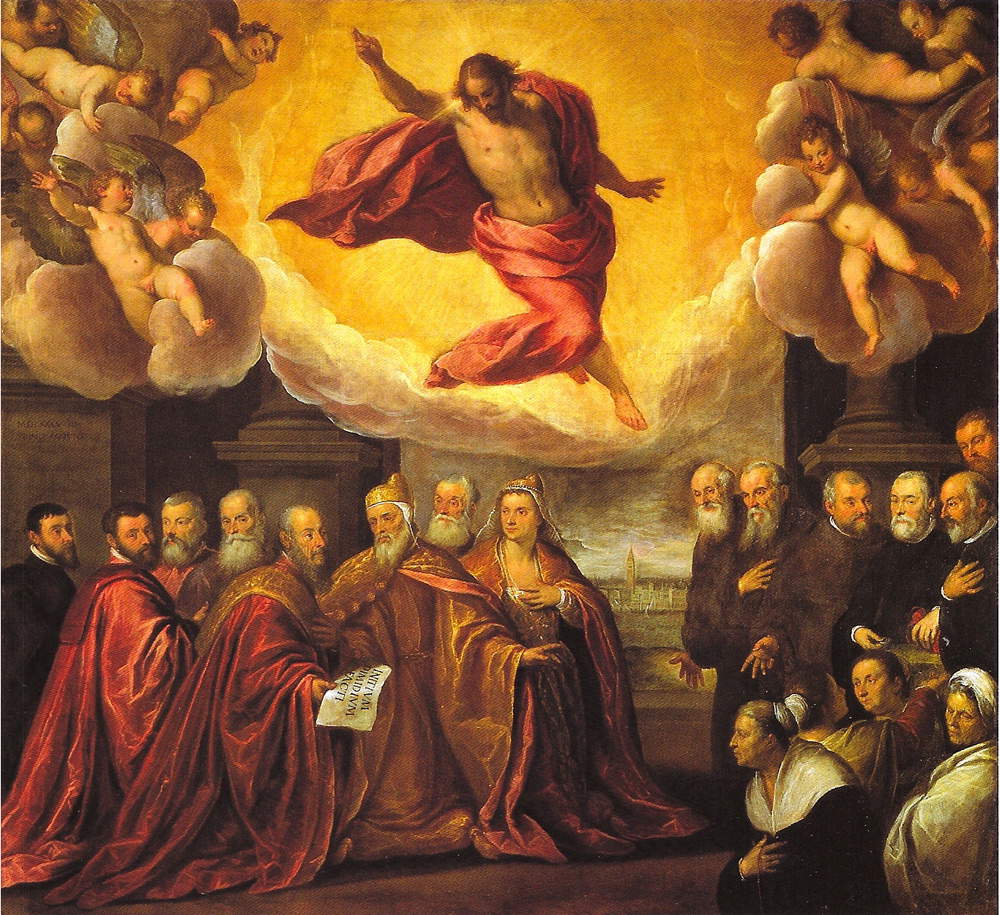 |
| Palma il Giovane, Christ in Blessing Glory, Doge Renier Zen, the Dogaressa and Procurators of St. Mark, some Crucifer fathers and women of the hospice (1585; oil on canvas, 390 x 350 cm; Venice, Oratorio dei Crociferi) |
The eight canvases, made, as mentioned, towards the end of the 16th century by Palma il Giovane, tell the story of the Order of the Cru ciferous and can be divided into three categories: the history of the Cruciferous and their hospital, the function of the O ratory as a chapel in a hospice, and the liturgical character of the Oratory as a chapel. The pictorial cycle obviously begins with the establishment of the congregation with the painting placed beside the altar and depicting Pope Cletus establishing theOrder of the Cruciferous, where four friars are depicted receiving from the pope the missive thanks to which the Cruciferous fathers would be recognized as a religious order concerned with the protection of the Crusaders; on the other side of the altar, on the other hand, is the canvas depicting Pope Paul IV delivering a Brief to the Venetian ambassador: Doge Renier Zen had bequeathed a sum of money to the Crucifer Fathers, and depicted here is the moment when a Venetian ambassador delivers a document to the Crucifer Fathers to make them aware of this inheritance. These first two works appear connected through painted architectural arches, intending to symbolize theunion between Rome and Venice; in fact, the first painting is set in Castel Sant’Angelo, while in the second the Campo dei Gesuiti is clearly visible.
Opposite the entrance to the Oratory, on the other hand, are three canvases whose protagonist is Pasquale Cicogna, the doge protector of the Crucifers who commissioned the entire decoration of the Oratory from Palma il Giovane (and whose payments we have evidence of having received from the artist). The first of these depicts Pasquale Cicogna, then the future doge, attending Mass celebrated by Father Priamo Balbi in the company of destitute women inside the Oratory. The scene is accompanied by an inscription expressing a prayer for his future election as doge: “UT PRAESENTEM VIRUM AMPLISS.D. MARCI PROCURAT. IN LOCUM DEMORTUI PRINCIPIS SUBSTITUAS. TE ROGAMUS DOMINE XV AUGUSTI M.D. LXXXV” (“Lord, we pray that you will replace the doge who has just passed away with this exceptional man, procurator of St. Mark’s”: the date follows, August 15, 1585, three days before Pasquale Cicogna was appointed doge). It is extraordinary to note that both the position of the altar and the structure of the wooden benches are identical to those still visible today. Already a great art historian such as Adolfo Venturi considered this scene to be Palma il Giovane’s masterpiece, and in general all critics have spoken favorably of this extraordinary canvass. “On the scene squared off with still sixteenth-century sobriety,” Giovanni Mariacher wrote, for example, in 1980, “move the characters, all carefully portrayed with almost verist taste; the same natural love seems to have inspired all the details of this interior, the flowers in the white vases arranged above the dossals, the Crucifix and the altarpiece painted on the altar, the oriental carpet covering the kneeler. These are, like the careful study of the faces, so many Bassano memories.” It continues with the scene in which Pasquale Cicogna receives the announcement of his appointment as Doge of Venice from the prefect: this time, however, the painting is set inside the Jesuit Church, as can be seen from the staircase. The third work dedicated to Cicogna depicts him as a doge dressed in gold as he visits the Church of the Crociferi: in the background the facade of the sacred building is recognizable, and in the foreground are portrayed some of the women welcomed as guests. Pietro Zampetti described Pasquale Cicogna’s stories as “Palma’s most renowned”: paintings that “seem to be the equivalent of the so-called ’reformed Mannerism,’ that is, eclectic halfway between Mannerism and Nature, in a cultural context akin, albeit slightly in advance, to that of the Carracci. The subject matter, however, Venetically fat and juicy as well as the realistic but also affectionate attention to humanity represented by the old hospitalized men, are already a seventeenth-century phenomenon that may have interested Strozzi” (the reference is to Bernardo Strozzi, a great Genoese painter who ended his career in Venice).
The last three paintings refer to the liturgical character of the Oratory as a chapel and are placed above the entrance to the Oratory, along the path that led to the burial place, and at the exit to the old hospice, respectively. Underscoring the purely religious aspect of the place is the presence in these paintings of Jesus Christ: the first has as its subject the Flagellation of Christ for the purpose of reminding the visitor of the suffering of humanity and the necessary purification of the individual to access the holy place. Concerning this scene, scholar Stefania Mason Rinaldi has written that “it is Palma’s that is a composition firmly framed in Sansovino and Palladian architecture, animated by robust and well-posed figures but lacking in spiritual tension, as theartist seems to want to bring out more of the formal and compositional possibilities of the scene, so that the apparent violence of the flagellators finds no echo in the absorbed, motionless spectators nor in the heavy figure of Christ.” And again, “the search for figures wedged in space, for bold foreshortening and the emphasis of certain gestures, for a neo-Mannerist vocabulary already surfacing in the immediately preceding works, finds fuller expression here.” The art historian found the precedent for this Flagellation (as well as for the Cavalier d’Arpino print, cited by Ridolfi, with which Palma’s work was compared, in a Roman work: the Flagellation that Federico Zuccari (Sant’Angelo in Vado, 1539 - Ancona, 1609) painted for the Oratory of the Gonfalone in Rome, or the one that his brother Taddeo (Sant’Angelo in Vado, 1529 - Rome, 1566) also executed in thethen capital of the Papal States for the church of Santa Maria della Consolazione (from the compositions of the two painters from the Marche region would derive the setting with the tall colonnade in the center of the scene, while the torturer on the right, the one bent over with his arm touching his knee, is an almost direct quotation). The Transport of Christ, on the other hand, exemplifies the passage of the hospital’s guests to the afterlife: Jesus died and the transport of his body is depicted here, paralleling the actual journey in the architectural complex that led to the place where the deceased guests were buried; to console and protect the poor women, the Madonna with angels was placed on the decorated ceiling above the mass grave.
The cycle concludes with the particularly crowded eighth canvass intended to signify both the religious character of the Oratory and the contemporary events at Palma the Younger: the painting is divided into two distinct parts and depicts Christ in blessing glory, Doge Renier Zen, the Dogaress and Procurators of St. Mark’s, some Crucifer fathers and women of the hospice. Looking at it, even without knowing the identities of the protagonists, one can perceive that almost all the characters connected with the history of the place are portrayed here. In the lower part, on the left, the artist places Doge Renier Zen, Dogaressa Aloisa, the procurators of St. Mark’s and some famous figures of the Venetian nobility, while on the right he inserts the Cruciferous Fathers and some infirm women in the act of devotion. The upper part shows Jesus Christ addressing, illuminated by a warm enveloping light, a blessing gaze to Doge Zen. St. Mark’s Square is recognizable in the background. Also on the altar today is a Vesperbild, a painted wooden Pietà, which refers to the Passion and Death of Christ: it was formerly located inside a chapel on the second floor of the hospice and was generally venerated by the elderly women guests there.
The importance of Palma il Giovane’s cycle has always been known, and all those who, even in ancient times, compiled guides to Venice could not help but mention the Oratorio dei Crociferi. Today, this environment, managed by the Venice Services Foundation, is part of the so-called "Hidden Jewels of Venice": a complex of unique places in the historic center of the lagoon capital, little if at all beaten by mass tourism, and which for the most part still retain their ancient appearance and the essence of the places.
Essential Bibliography
Warning: the translation into English of the original Italian article was created using automatic tools. We undertake to review all articles, but we do not guarantee the total absence of inaccuracies in the translation due to the program. You can find the original by clicking on the ITA button. If you find any mistake,please contact us.